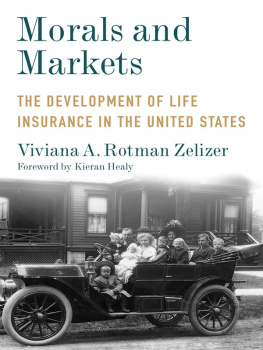Table of Contents
Morals and Markets
Legacy Editions
Legacy Editions
Edited by Howard S. Becker and Mitchell Duneier
Learning to Labor: How Working-Class Kids Get Working-Class Jobs, Paul Willis, with foreword by Stanley Aronowitz
The Levittowners: Ways of Life and Politics in a New Suburban Community, Herbert J. Gans, with foreword by Harvey Molotch
On Becoming a Rock Musician, H. Stith Bennett, with foreword by Howard S. Becker
Morals and Markets
THE DEVELOPMENT OF LIFE INSURANCE IN THE UNITED STATES
Viviana A. Rotman Zelizer
With a Foreword by Kieran Healy
Columbia University Press / New York
As a dissertation this book was awarded the Bancroft Dissertation Award by a committee of the faculty of the Graduate School of Arts and Sciences of Columbia University.
Columbia University Press
Publishers Since 1893
New York Chichester, West Sussex
cup.columbia.edu
Copyright 1979 Columbia University Press
Foreword 2017 Columbia University Press
All rights reserved
E-ISBN 978-0-231-54542-6
ISBN 978-0-231-18334-5 (cloth : alk. paper) |
ISBN 978-0-231-18335-2 (pbk : alk. paper) |
ISBN 978-0-231-54542-6 (e-book)
Library of Congress Control Number: 2016957445
A Columbia University Press E-book.
CUP would be pleased to hear about your reading experience with this e-book at .
Cover design: Mary Ann Smith
Cover image: Vintage*Kids / Alamy
For my mother, Rosita Weill de Rotman and my father, S. Julio Rotman, who would be my great friends even if they were not my parents.
Contents
Kieran Healy
I n October 2016, MetLife fired Snoopy. The New Yorkbased insurance company had been endorsed by the beloved beagle, together with other members of the Peanuts gang, for more than thirty years. During that period Snoopy appeared in MetLifes advertisements, in their logo, on the company blimp that floated over fairways at PGA tournaments, and on the business cards of its sales agents and executives. The firms Stationery Brand Guidelines recommended Snoopy appear on employee cards, but cautioned that he should only be shown in his brand ambassador pose, trotting along with his arms outstretched in a carefree fashion. Snoopy has long been a beloved figure in American culture, but sadly, in capitalism, all that is solid melts into airor, as the companys press release put it, Around the globe, change is happening faster than ever beforeconsumers are overwhelmed with the pace of change and are looking for a trusted partner to help them navigate these changes. MetLife decided to reorganize its business, and the restructuring left no room for a cartoon dog. The companys global chief marketing officer, Esther Lee, commented, It is to the best interest of all policyholders that they shall be taught to regard life insurance as a practical business institutionmanaged on purely business principles, and to be judged only by rules of recognized business procedure. The sooner they learn to sever it from all connection with impractical sentiment, the better it will be for them.
Their statements are less blunt than Standens, but they are recognizably in the same vein. There was a time, they say, when we needed Snoopy to make life insurance seem warm and welcoming, but those days are gone. It is now timeand, more to the point, it is justification enoughto think of MetLife in directly economic terms, without any softening distraction.
We might be a little skeptical of the MetLife executives gesture backwards towards that simpler time in American life when people needed to be coddled a little about the harsh realities of the insurance business. They are, after all, talking about the mid-1980s, a period when Wall Street (the institution) and Wall Street (the motion picture) were both strong advertisements among many others for straightforward self-interest in economic life. Whatever story is behind an insurance firms initial need to sweeten its public image, and its subsequent willingness to cast off the safety blanket, it seems it ought to have deeper roots than that.
Morals and Markets is a study of what those roots might be. First published in 1979, it is Viviana Zelizers first book. She followed it with a series of worksPricing the Priceless Child, The Social Meaning of Money, and The Purchase of Intimacythat had a formative influence on both the sociology of economic life and the sociology of culture. When revisiting the early work of a scholar who set and sustained an important research agenda, as Zelizer did, one is always curious to see how much of the past has since been forgotten in the literature, and how much of the future is already there on the page.
Like many first books, Morals and Markets shows some evidence of its origins as a dissertation, notably in the way the argument is framed, and in its nods to the work of the sociologists at Columbia who mentored the author. But it does not read like a dissertation. The prose is lucid and the pace is brisk. We get through the first three chapters in fewer than forty pages. Zelizer sets up the problem efficiently. Life insurance companies were established in the United States toward the end of the eighteenth century, and seemed a strong solution to the financial problems of widows and orphans. But they failed to thrive. People would not buy what the companies had to sell. After the 1840s, however, this changed. Life insurance began a period of rapid expansion culminating in its consolidation as a large market. What accounts for life insurances early failure and its subsequent success? Zelizer examines existing explanationsmostly structural or economicand finds them insufficient: the means to pay for life insurance existed early on; other forms of insurance (such as fire and marine policies) were successfully sold with little fuss; insurance companies were generally well-run; the law was no obstruction; the right sort of knowledge and data about mortality rates were available; and the policies were not terrible. But life insurance, in particular, faced a distinctive sort of resistance from potential customers. Even one of the more plausible explanations for the industrys eventual successits recruitment of an army of high-pressure sales agents and marketerspresupposes that there was some special problem with life insurance that needed a crack team of salesmen in the first place.
The remaining chapters of Morals and Markets try to solve this puzzle. The overarching idea is that we need to account for American culture and values surrounding death to understand why Americans impeded the development of the life insurance market for half a century or more. At this point, one could write a summary sentence or two that might be found in many discussions that cite the book in passing: Morals and Markets shows how the introduction of calculative market principles into a sacred sphere, that of death, provoked a surprisingly strong resistance that took time and effort to overcome. Market success for the insurance industry eventually came not through the elimination or replacement of peoples sacred values with something more instrumental, but in a more interesting way, through a kind of partial co-optation: Theology yielded to the capitalist ethosbut not without compelling the latter to disguise its materialist mission in spiritual garb (see page 176).










